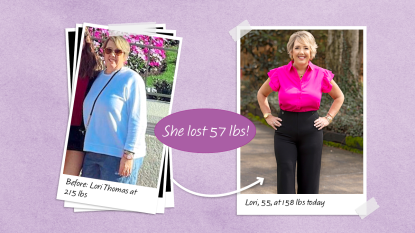What Is Cardiovascular Disease — Exactly? This Definition and Warning Signs Could Save Your Life
The (heart)beat goes on.

As you go through your day, you may not think about your heart, the organ central to your life as it pumps blood throughout your body. But that can change quickly if you experience a potentially frightening heart health wake-up call. Maybe a friend or relative has died unexpectedly of a heart attack. Or you have some unusual chest pain or feel palpitations and wonder if your own ticker has a problem. Perhaps, like countless others, you get news from your doctor that tests show you are at risk for — or already have — heart disease.
There’s no doubt that concern about your heart health can make you feel vulnerable and spark worries about your mortality. But consider this: Having a warning about your heart isn’t necessarily a bad thing. In fact, there’s tremendous risk in not knowing the status of your heart and vascular health.
Despite the sobering statistics about heart disease — it’s the leading cause of death in the US— there’s good news. Researchers have found proven ways to lower your individual risk for cardiovascular disease. What’s more, even if you already have been diagnosed with heart disease or a related condition, advances in treatments over the past decade are providing hope for longer and healthier lives for people who commit to following through with recommended treatments, including not only medications and procedures, if needed, but also lifestyle changes like exercising and getting weight, blood pressure, and cholesterol under control.
Defining Heart Disease
Heart disease is an all-encompassing term for conditions affecting many parts of the heart and circulatory system, including congenital heart defects, glitches in the heart’s electrical system causing abnormal rhythms (like atrial fibrillation), problems with heart valves, heart failure, damage from infections like rheumatic fever, and cardiomyopathy. But the most common type of heart disease by far is coronary artery disease (CAD), which kills more than 370,000 people in the US each year.
CAD is primarily caused by atherosclerosis — deposits of plaque (made up of cholesterol and other substances) that build up in the coronary arteries, the major blood vessels that supply your heart with blood, oxygen, and nutrients. The plaques narrow arteries and can compromise blood flow, which can eventually result in a heart attack.
Researchers believe plaque starts when an artery’s inner lining becomes damaged, likely from inflammation. Causes include high blood pressure and elevated levels of fats found in the blood (primarily triglycerides and the “bad” cholesterol known as LDL). Smoking is also linked to atherosclerosis, according to the American Heart Association.
“Cardiovascular disease can affect your whole vascular system, causing cerebral vascular disease [which affects the arteries going to the brain] and coronary artery disease,” says cardiologist Laurence Sperling, MD, director of the Emory Heart Disease Prevention Center in Atlanta.
As plaque increases over many years, narrowed artery walls make it harder for blood to flow through your body. If your heart muscle doesn’t get enough blood, you might experience the pain known as angina, a warning sign of heart disease. In fact, it’s the most frequent symptom of CAD, characterized by squeezing or pressure-type pain in the chest (and sometimes the shoulders, arm, neck, back, or jaw).
Stable angina comes and goes, with symptoms most often occurring during physical activity or periods of stress. Nitroglycerin is prescribed for angina patients to use during these attacks because it widens blood vessels, aiding blood flow and relieving symptoms. However, unstable angina (chest pain occurring at rest for no known reason) is a medical emergency and can indicate an impending heart attack.
People who are unaware they have cardiovascular disease may be taken by surprise when a heart attack strikes. Plaque in an artery ruptures, triggering the formation of a blood clot and shutting off the blood flow through the artery. The heart muscle is starved for oxygen, a condition known as ischemia.
Although cardiovascular disease is typically equated with the heart, it can affect an artery carrying blood to the brain the same way it affects a heart-connected artery. While heart attacks caused by cardiovascular disease can create sudden chest pain, a stroke from cardiovascular disease can lead to a sudden, severe headache. As the blood supply to the brain is blocked, an ischemic stroke occurs. Symptoms often include sudden numbness of the face, leg, or arm on one side of the body, confusion, and balance and vision issues.
Peripheral arterial disease (PAD) also results from atherosclerosis, blocking blood flow and oxygen to the arm and leg muscles, resulting in leg pain, numbness, and swelling in the ankles and feet. “Cardiovascular disease can even affect capillaries (the smallest blood vessels in the body),” Dr. Sperling points out.
Signs of Trouble
Atherosclerosis doesn’t come out of the blue; it develops over many years and can sometimes start in childhood. So how do you find out if you have cardiovascular disease without a health crisis? And if your heart and vascular system isn’t seriously clogged with plaque, how can you keep it that way? Cardiologists have simple and high-tech ways to answer those questions.
To look for warning signs that you may have risk factors for cardiovascular disease — or some degree of the condition — your doctor will take a family history to find out if any close relatives have had heart attacks or strokes (it can have a genetic component) and a personal history. You might have existing health conditions that raise the risk for cardiovascular disease, especially type 2 diabetes and obesity.
Your diet, whether you exercise regularly or not, and whether you drink alcohol, smoke, or indulge in recreational drugs are also factors that all play a role in cardiovascular risk.
Standard cardiovascular risk assessment tests include blood pressure readings, a calculation of your body mass index (a measure of body fat based on height and weight) to see if you are carrying excess pounds, and blood tests to check for high cholesterol, triglyceride levels, and diabetes. Inflammation from many causes, not just cardiovascular disease, increases C reactive protein (CRP) in your blood. Your doctor may order a test to measure CRP as part of an overall assessment.
Even without overt symptoms, you might have signs that suggest a cardiovascular problem, including shortness of breath, swelling of the lower legs, and unusual fatigue.
Depending on your age and other factors, your doctor may run some tests to check your heart health, including an EKG to measure the electrical activity and regularity of your heartbeat, an ultrasound or other cardiac imaging to create a picture of your heart, and an exercise stress test to determine how well your heart works while under physical exertion. If you have known or suspected cardiovascular disease, cardiac catheterization can check the inside of arteries for blockages that may need to be opened and stented.
Know Your Guidelines
Research has shown that optimal management and prevention of cardiovascular disease means aiming for lower levels of blood pressure and cholesterol than those considered acceptable not too long ago. For example, the American Heart Association (AHA) and American College of Cardiology (ACC) have updated the definition of high blood pressure as a reading of 130/80, compared to the previous definition of 140/90.
The AHA and ACC’s new cholesterol guidelines emphasize lifestyle factors including eating a healthy diet rich in vegetables and low in fat and sweets, weight control, and regular exercise to reduce cholesterol. When that’s not enough, a prescription class of drugs called statins may be necessary. For those who have already experienced a heart attack or stroke, even newer or more powerful cholesterol-lowering drugs are available.
“High-cholesterol treatment is not one size fits all, and this guideline strongly establishes the importance of personalized care,” notes Michael Valentine, MD, a Lynchburg, VA-based cardiologist and the president of the ACC.
Help Yourself
Whether you have, or are at risk for, cardiovascular disease — or just want to keep your heart as healthy as possible — you need to be a key part of the “prescription.”
“By being informed and understanding your own risk, you can be empowered going into your healthcare encounter, so you can work with your clinician on a plan to appropriately modify your personal risk,” advises Dr. Sperling. “We know we can dramatically impact arterial disease. We can limit the progression of the disease, which will change the trajectory and reduce the chances of people manifesting overt, critical syndromes or events.”
And while we may not eliminate cardiovascular disease, there is hope we can change the outcome. “The course of the disease can be reversed through a combination of behavior and lifestyle changes and sometimes the need for medical therapies, so it is definitely possible,” says Dr. Sperling.
A version of this article appeared in our partner magazine, The Complete Guide to Heart Health, in 2019.













